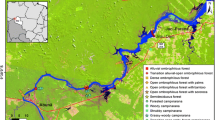Summary
In the northern part of the Great Dyke, Rhodesia, the physiognomic and floristic differences between the vegetation types on serpentine and on non-serpentine substrates are very striking and the boundaries between these types are generally sharp. On either of the substrates there are also differences in the vegetation which correspond to differences in habitat. An outline of the Great Dyke environment is given. A number of plots, laid out in transects across the Great Dyke, were sampled according to the Braun-Blanquet approach. Six plant communities are distinguished and described in detail: one occurring on granite, two on pyroxenite and three on serpentine. The syntaxonomy of these communities is discussed. A riverine forest community which strongly differs from all these vegetation types is also described.
Similar content being viewed by others
References
Blackshaw, G.N. 1921. Magnesia impregnated soils. J.S. Afr. Sci. 17: 171–178.
Duvigneaud, P. 1958. La végétation du Katanga et de ses sols métallifères. Bull. Soc. Roy. Bot. Belg. 90: 127–286.
Ernst, W.H.O. 1971. Zur Ökologie der Miombo-Wälder. Flora 160: 317–331.
Ernst, W.H.O. 1974. Schwermetallvegetation der Erde. Fischer, Stuttgart.
Harrison, A.D., Nduku, W. & Hooper, A.S.C. 1966. The effect of high magnesium-to-calcium ratio on the egg-laying rate of an aquatic planorbid snail, Biomphalaria pfeifferi. Ann. Trop. Med. & Parasit. 60: 212–214.
Henkel, J.S. 1931. Types of vegetation in southern Rhodesia. Proc. Rhod. Sc. Ass. 30: 1–23.
Knapp, R. 1965. Pflanzengesellschaften und Vegetations-Einheiten von Ceylon und Teilen von Ost- und Central-Afrika. Geobot. Mitt. Giessen 33: 1–31.
Krause, W. 1958. Andere Bodenspezialisten. Handb. der Pflanzenphysiologie 4: 755–798.
Lawton, R.M. 1972. An ecological study of miombo and chipya woodland with particular reference to Zambia. Unpubl. Ph. D. Thesis, Univ. of Oxford.
Lötschert, W. 1969. Pflanzen an Grenzstandorten. Fischer, Stuttgart.
Malaisse, F., Freson, R., Goffinet, G. & Malaisse-Mousset, M. 1975. Litter fall and litter breakdown in miombo. In: F.B., Golley & E., Medina (ed.), Tropical Ecological Systems. Ecol. Stud. 11, pp. 137–152. Springer, Berlin, New York.
Proctor, J. & Woodell, S.R.J. 1975. The ecology of serpentine soils. Adv. Ecol. Res. 9: 256–366.
Proctor, J. & Craig, G. C. (in press). The occurrence of woodland and riverine forest on the serpentine of the Great Dyke. Kirkia 11.
Rattray, J.M. & Wild, H. 1961. Vegetation map of the Federation of Rhodesia & Nyassaland. Kirkia 2: 94–104.
Schmitz, A. 1963. Aperçu sur les groupements végétaux du Katanga. Bull. Soc. Roy. Bot. Belg. 96: 233–447.
Schmitz, A. 1971. La végétation de la plaine de Lubumbashi (Haut-Katanga). Publ. I.N.E.A.C. Sér. Sc. 113: 1–390. Bruxelles.
Schulze, R.E. & McGee, O.S. 1978. Climatic indices and classifications in relation to the biogeography of southern Africa. In: M.J.A., Werger (ed.), Biogeography and ecology of southern Africa. pp. 19–52. Junk, The Hague.
Walker, R.B. 1954. The ecology of serpentine soils. II. Factors affecting plant growth on serpentine soils. Ecology 35: 259–266.
Walter, H. & Lieth, H. 1960–1967. Klimadiagramm-Weltatlas. Fischer, Jena.
Werger, M.J.A. 1974. On concepts and techniques applied in the Zürich-Montpellier method of vegetation survey. Bothalia 11: 309–323.
Werger, M.J.A. & Coetzee, B.J. 1978. The Sudano-Zambezian Region. In: M.J.A., Werger (ed.), Biography and ecology of southern Africa. pp. 301–462. Junk, The Hague.
Westhoff, V. & Van der, Maarel, E. 1973. The Braun-Blanquet approach. In: R.H., Whittaker (ed.), Handbook of Veg. Science 5, pp. 617–726. Junk, The Hague.
Wild, H. 1965. The flora of the Great Dyke of southern Rhodesia with special reference to the serpentine soils. Kirkia 5: 49–86.
Wild, H. 1974. Variations in the serpentine floras of Rhodesia. Kirkia 9: 209–232.
Wild, H. 1975a. Termites and serpentines of the Great Dyke of Rhodesia. Trans. Rhod. Sc. Ass. 57: 1–11.
Wild, H. 1975b. The uptake of heavy metals by some succulent species of Rhodesian serpentines. Excelsa 5: 17–22.
Wild, H. 1978. The vegetation of heavy metal and other toxic soils. In: M.J.A., Werger (ed.), Biogeography and ecology of southern Africa. pp. 1301–1332. Junk, The Hague.
Wild, H. & Barbosa, L.A. Grandvaux. 1967. Vegetation map of the Flora Zambesiaca area. Flora Zambesiaca supplement, 71 pp. Collins, Salisbury.
Wild, H. & Bradshaw, A.D. 1977. The evolutionary effects of metalliferous and other anomalous soils in South Central Africa. Evolution 31: 282–293.
Whittaker, R.H. 1954. The ecology of serpentine soils. IV. The vegetational response to serpentine soils. Ecology 35: 275–288.
Author information
Authors and Affiliations
Additional information
Nomenclature is according to the present (1.1.1977) usage at the National Herbarium, Salisbury, Rhodesia.
One of us (M. J. A. Werger) wishes to gratefully acknowledge the financial support for this study by the Netherlands Foundation for the Advancement of Tropical Research (WOTRO) and by the Faculty of Science, University of Nijmegen.
Rights and permissions
About this article
Cite this article
Werger, M.J.A., Wild, H. & Drummond, B.R. Vegetation structure and substrate of the northern part of the Great Dyke, Rhodesia environment and plant communities. Vegetatio 37, 79–89 (1978). https://doi.org/10.1007/BF00126831
Accepted:
Issue Date:
DOI: https://doi.org/10.1007/BF00126831




